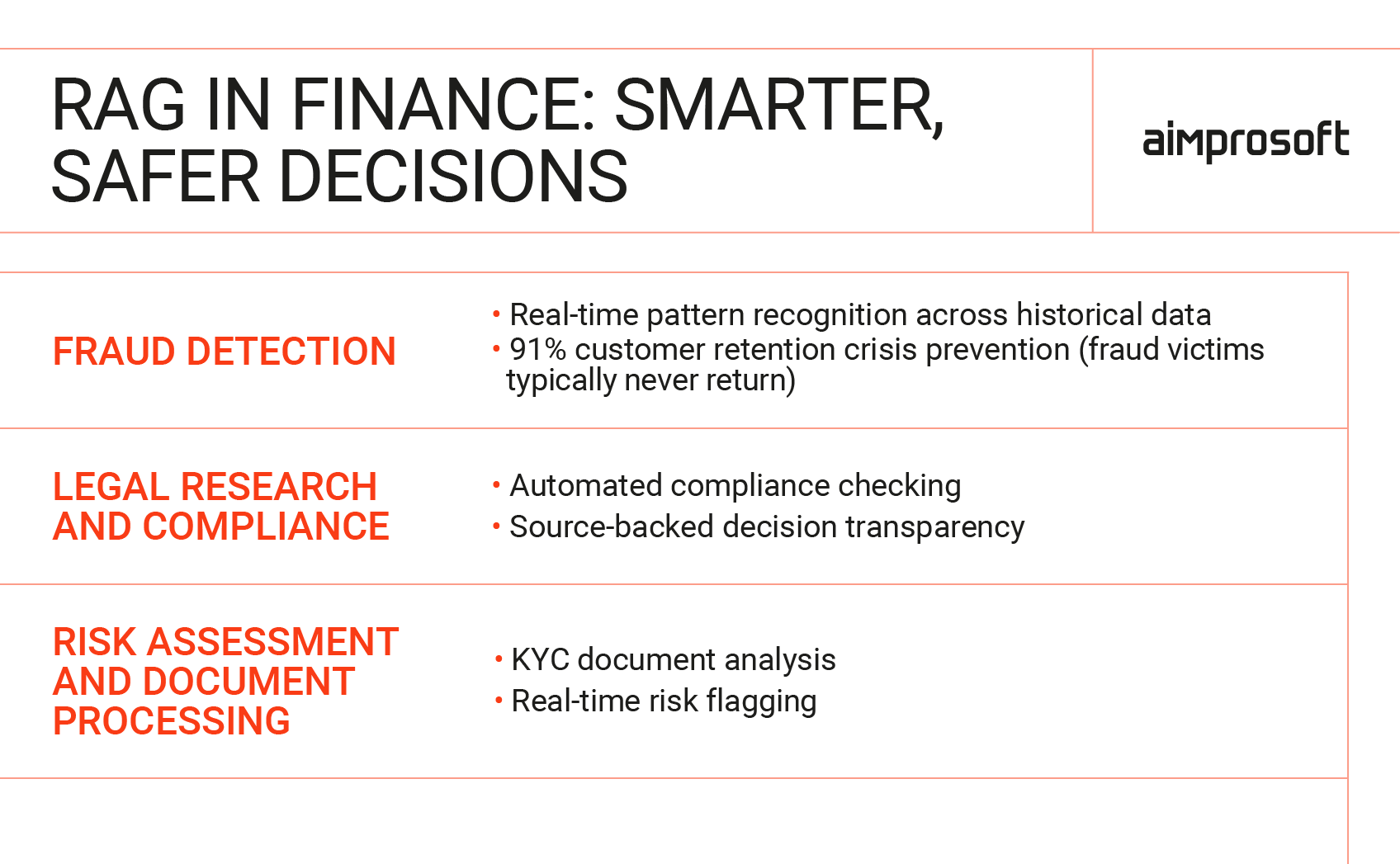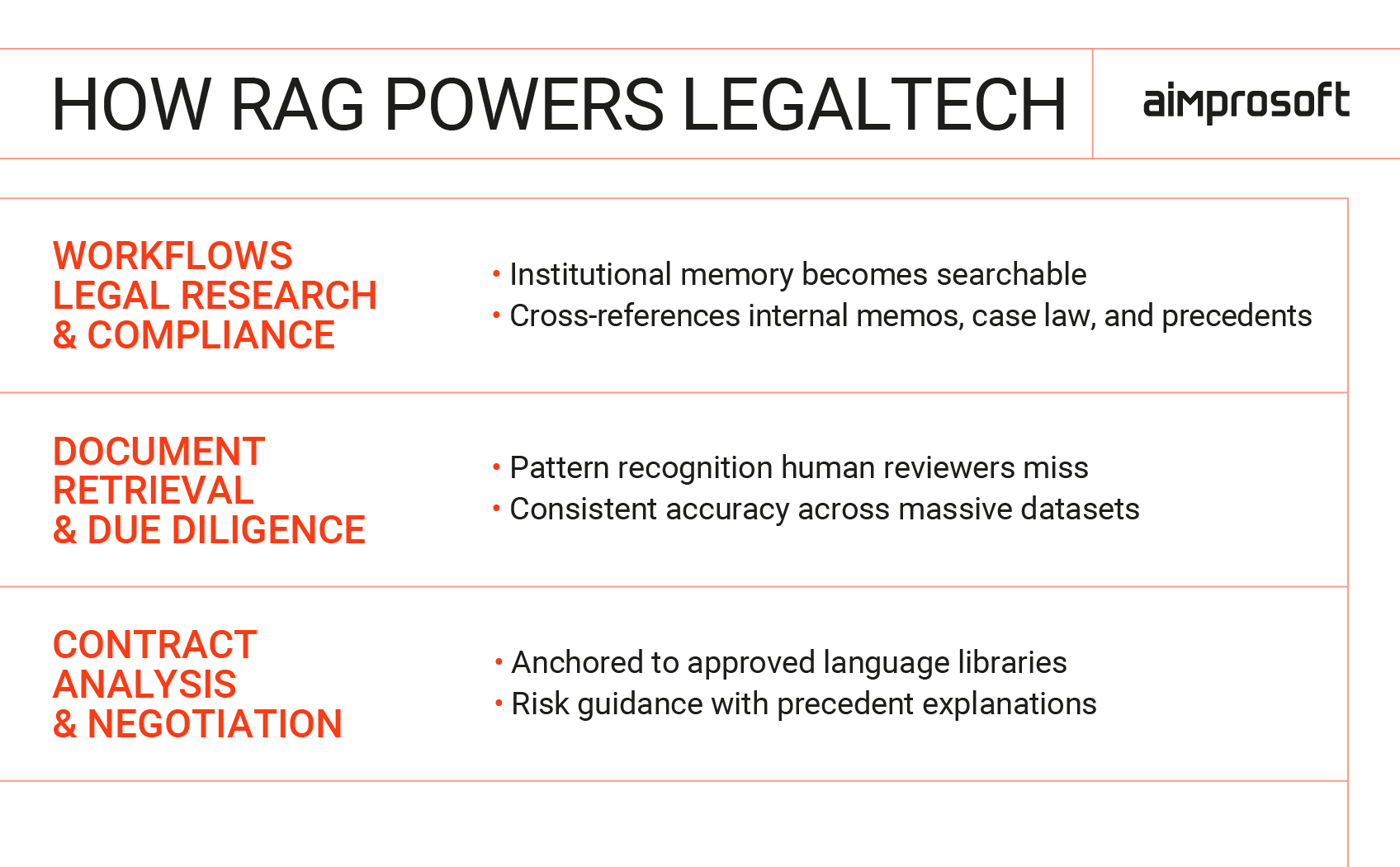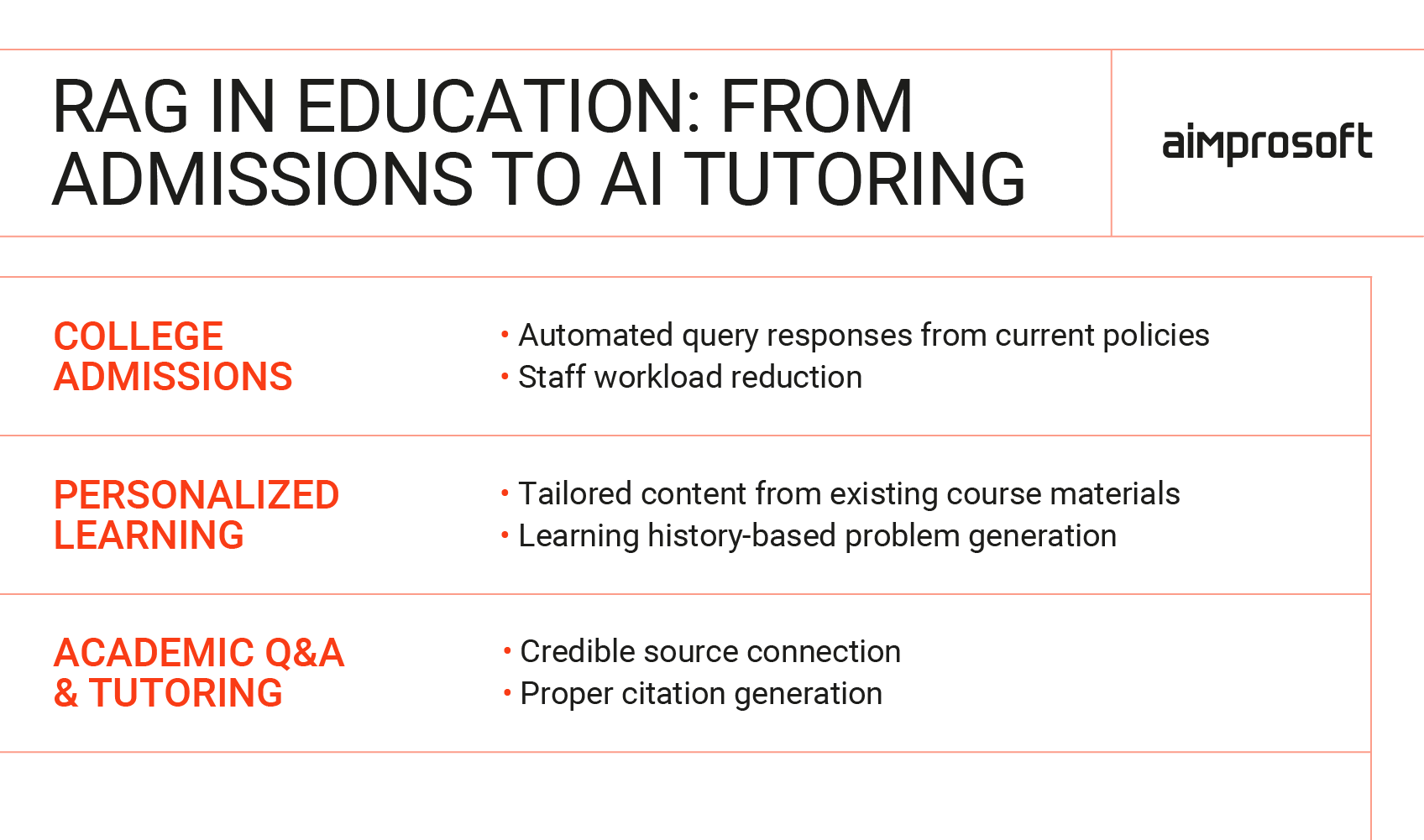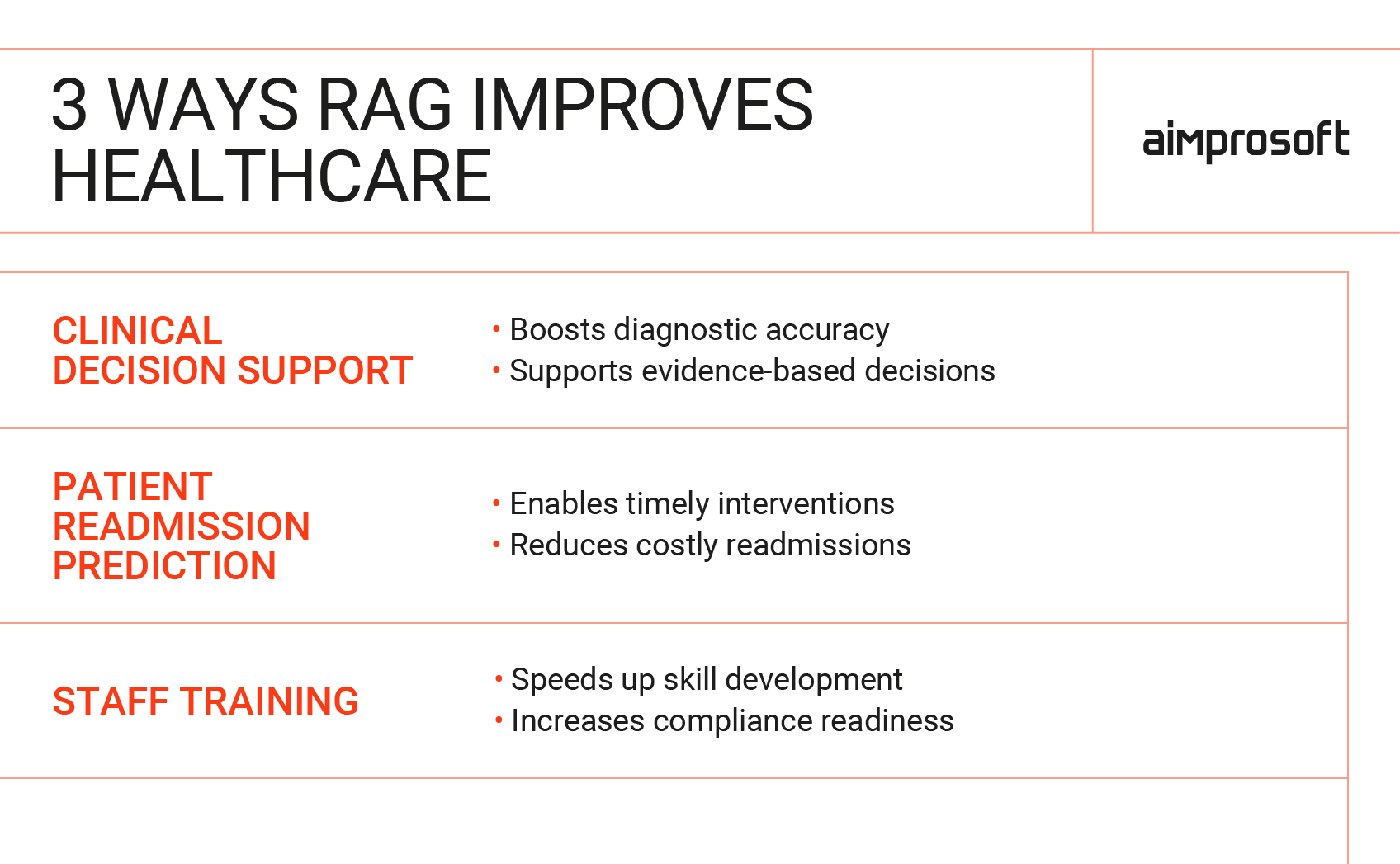Best RAG Use Cases in Business: From Finance and LegalTech to Healthcare and Education
Here’s the uncomfortable truth about AI applications in business: no matter how powerful the hardware or premium the subscription you choose, if you work in a high-stakes industry, it won’t have access to your actual knowledge.
The problem isn’t training data or model size – it’s that your most critical information lives where AI can’t reach it. Healthcare protocols, legal precedents, financial regulations, educational standards are locked away in proprietary databases, constantly updating document systems, and secure repositories.
Sure, you could keep retraining your models every time something changes. Some organizations do exactly that. But retrieval augmented generation (RAG) solutions solve this by eliminating the need for constant AI maintenance and retraining.
RAG accesses your actual, current knowledge the moment it’s needed. In other words, it helps your AI act less like a guessing engine and more like a teammate who knows where to look up information.
Which brings us to the obvious next question: what are some practical applications of RAG in real-world scenarios?
Let me walk you through the most compelling ones.
Retrieval-augmented generation examples: Where RAG outperforms standalone LLMs
RAG isn’t just another technical acronym to impress stakeholders; it’s a strategic response to a problem many organizations don’t even realize they have. Yes, large language models (LLMs) have undoubtedly transformed how businesses handle content creation, customer support, and internal operations. But on their own, they still have some limitations –especially when accuracy, real-time updates, and traceability are non-negotiable.
This is where the real shift begins. As we explored in our deep dive on private LLMs for enterprises, more and more companies are moving away from one-size-fits-all AI in favor of solutions that offer customization and control. RAG represents the next logical step: intelligent, traceable AI that stays current with your actual business data.
So, what does that look like in practice? Let’s break down what the benefits of using RAG over a standard LLM for specific use cases.
- First, accuracy you can trust. While traditional LLMs work from their training data (which might be months or years old), RAG pulls from your current, verified sources every single time. No more second-guessing whether that compliance answer reflects the latest regulations.
- Second, transparency in decision-making. When RAG gives you an answer, it shows you exactly which documents it used. Try getting that level of citation from a standard LLM, and you’ll be waiting a while.
- Third, effortless knowledge updates. Instead of expensive model retraining every time your policies change, you simply update your source documents. RAG will automatically have access to the new information.
These aren’t just abstract advantages – these are AI benefits that can be yours. Here’s how enterprise RAG solutions make them happen across different industries.
RAG in finance
In financial services, information isn’t just power – it’s protection. The difference between catching fraud early and missing it entirely often comes down to having the right context at the right moment.
Now, even with qualified analysts, things get missed – humans have blind spots, and traditional AI hallucinates. What you need is something that can surface connections across your entire data ecosystem in seconds, not hours – which is exactly why AI assistants for financial reporting and AI knowledge bases for fintech are becoming essential tools.

#1 RAG AI for fraud detection and prevention
Fraud is not just a security issue, but a customer retention crisis. According to Mastercard, 91% of users who experience fraud on a company’s platform say they won’t use that company again. That’s a staggering loss of trust, revenue, and long-term customer value.
Real-time fraud detection depends on timely, contextual information – from emerging fraud patterns to regulatory updates and individual customer history. Standard fraud systems can flag anomalies, but they can’t adapt when new threats emerge or compliance rules shift. And without expensive retraining, you’re stuck working with yesterday’s threats.
RAG for fraud detection in finance goes further. It can surface historical data on similar fraud attempts, incorporate the latest compliance rules, and cross-reference them with customer activity, all in real-time. This is how generative AI in banking operations shows its real value – by connecting dots that traditional systems miss. RAG can reduce false positives, improve detection precision, and provide transparent, source-backed reasoning for each decision.
#2 RAG AI in legal research and compliance
Compliance teams live with a moving target. Regulations evolve fast, and staying current is expensive and time-consuming. Beyond finding answers, you need to apply rules consistently across different processes and decisions.
But what if instead of chasing down documents or emailing legal, they could ask a RAG-powered assistant, or in other words, AI assistants for finance?
The system retrieves relevant guidance – both internal and external – and delivers a clear explanation with citations, reducing time to resolution and audit risk. RAG represents a fundamental shift in AI for risk management from reactive compliance to proactive alignment.
A good example of RAG’s work in action comes from the fintech company Ramp. Their team moved from a fragmented, homegrown customer classification approach to a standardized NAICS-based system using RAG. NAICS offers uniform industry codes, which simplify categorization, improve reporting precision, and strengthen compliance checks. Thanks to RAG’s ability to access authoritative documents and offer reliable guidance, Ramp created an AI assistant for financial reporting that reduced manual reviews and improved compliance.
#3 RAG for risk assessment and document processing
Whether it’s onboarding a new client or reviewing know-your-customer (KYC) documents, finance teams often juggle fragmented data and inconsistent criteria. One missing detail can compromise onboarding or trigger compliance issues.
AI copilots for finance teams can make the process faster. Teams can instantly retrieve and combine onboarding policies, risk models, and compliance checklists as needed. Combined with AI for financial document analysis, this approach transforms how financial institutions handle everything from loan applications to merger paperwork. It flags inconsistencies, highlights missing data, and links to trusted sources – all in real time.
ClearBank, a UK fintech clearing bank, has already implemented RAG‑powered pipelines to review onboarding documents and perform client screening. The system automatically compares KYC documents against internal policies and regulatory frameworks, effectively flagging risks and driving faster onboarding decisions.
RAG for legal tech
Picture this: It’s 11 PM, and your legal team is scrambling to find a clause buried somewhere in thousands of contracts from three years ago. Meanwhile, opposing counsel is breathing down your neck for a response by morning. Sounds familiar? Well, things could have been different with RAG AI copilots for legal teams.

#1 RAG AI in legal research and compliance
Most firms have decades of institutional knowledge locked away in emails, memos, and case files that might as well be invisible. This means a new associate working on a tough legal problem might never know their firm already tackled a similar issue just two years ago, or that their stance on a key rule changed after a big ruling last spring.
RAG in legaltech changes the game by enabling AI for legal document retrieval across internal memos, outside counsel opinions, case law databases, and prior filings. Thanks to the benefits of RAG AI, there’s no longer a need to start from scratch. This turns fragmented institutional memory into a searchable AI for a legal knowledge base.
Harvey, a legal AI startup, has built systems that make law firms’ proprietary databases searchable and actionable through these RAG-powered approaches. When Prof. Daniel Schwarcz tested this with law students, he found significant improvements in four out of six legal tasks. The improvements were not just in the speed of completing the tasks, but also in the clarity and professionalism of the output.
#2 RAG for legal document retrieval and due diligence at scale
Litigation and investigations often involve going through millions of emails, chats, PDFs, and other communications for just one case. Standard document review is expensive, time-consuming, and inconsistent, depending on who’s doing the work. This creates delays and inflates legal costs.
A UK-based law firm Addleshaw Goddard (AG) faced similar challenges. Yet, instead of using standard generative AI for legal compliance that gets overwhelmed by massive document sets, they implemented RAG for legal documents. This powered a more reliable AI for an internal knowledge retrieval system that could surface relevant materials from massive datasets.
By using this RAG AI application, the firm could access relevant precedents and spot patterns human reviewers might miss – all while maintaining a high standard of legal accuracy.
#3 AI for contract analysis (legal) and negotiation
Contract work presents a different headache entirely. Every MSA, NDA, DPA, and SOW needs to align with your playbooks, but maintaining consistency across hundreds of agreements manually is nearly impossible. One lawyer might accept language that another would flag as problematic.
AI for contract analysis (legal) powered by RAG changes this dynamic by anchoring decisions to your actual approved language and negotiation history. Instead of guessing whether a clause is acceptable, the system can retrieve approved clause libraries, past negotiated positions, and risk guidance – then point to specific precedents and explain why similar language was or wasn’t approved in the past.
Of course, the technology isn’t perfect. A recent Stanford study found that even specialized legal AI tools from major players like LexisNexis and Thomson Reuters still produce incorrect information 17-34% of the time. But it shows that AI in legal compliance works best as a support tool – amplifying legal expertise rather than replacing it.
RAG for education
Every semester brings the same chaos: course requirements shift every semester, departments tweak policies mid-term after committee reviews, and just when your generative AI for knowledge management in education catches up (the one they say is supposed to help) – info changes again. Seems like a dead end, but it’s not.

#1 RAG for college admissions
During enrollment season, admissions teams often find themselves repeatedly answering the same questions about deadlines, requirements, and program specifics. Instead of having staff manually respond to hundreds of these queries, some schools are getting smart about it. They’re exploring educational applications of RAG to build chatbots that don’t guess answers – but look up the current information from your admission guides, program catalogs, and internal policies.
Take Ho Chi Minh City University of Technology. They were skeptical too, but their RAG in education technology chatbot ended up matching expensive commercial systems in accuracy while cutting their staff workload significantly.
#2 AI personalized learning
Every student has their own pace and way of learning, yet providing each one with tailored explanations or customized materials would bankrupt any institution within a week. So why waste thin resources on inevitable, when AI for curriculum content generation powered by RAG can pull from your existing resources – lecture notes, textbooks, course materials – and automatically create personalized practice questions and explanations based on how each student learns best.
Whenever a student struggles with calculus, the system looks at their learning history and creates targeted practice problems using examples from their actual course content. Think of it as having a teaching assistant who knows every student’s learning style and can instantly pull together the right materials from your course library.
#3 RAG for tutoring and academic Q&A
You’ve probably been there: it’s 2 AM, you remembered about the assignment, the deadline’s looming, and your memory of the lecture notes is fuzzy at best. What’s your next move? Googling vague answers or trusting a ChatGPT response that sounds confident but cites nothing? Not exactly academically rigorous.
But what if students had access to AI assistants for academic research that could genuinely distinguish credible sources from internet noise? Retrieval augmented generation in edtech makes this possible by connecting students directly to peer-reviewed journals, course materials, and university databases, complete with proper citations.
The numbers back this up. A recent review of 47 published RAG chatbot studies in educational settings found strong results in tutoring, language learning, and STEM support – especially where accuracy and traceability matter.
RAG in healthcare
When a clinician makes a treatment decision at 4 AM, they need access not just to their patient’s complete history, but to the latest research, current protocols, and evidence-based guidelines. The stakes are too high for guesswork or outdated information.
And yet healthcare organizations are drowning in information scattered across electronic health records, medical literature, treatment protocols, and regulatory updates.

#1 AI in clinical decision support
RAG in healthcare applications proves most valuable in clinical decision support, where diagnostic accuracy can make a difference. AI for clinical knowledge base systems powered by RAG can pull both structured patient data and unstructured medical literature. They use this to generate diagnosis suggestions grounded on current guidelines, peer-reviewed research, and patient-specific history.
Crucially, they provide evidence of trials for every recommendation – something essential for both clinical confidence and legal compliance.
The MedRAG Framework demonstrates this in action. Their diagnostic RAG system improved diagnostic accuracy for chronic pain cases by 23% and reduced misdiagnosis rates in clinical testing by connecting real-time patient data with current treatment protocols and research findings.
#2 AI in patient re-admission prediction
Preventable re-admissions cost the U.S. healthcare system billions annually, yet hospitals struggle to predict which patients will return. Traditional systems analyze lab results, discharge notes, or social factors – but rarely connect all the dots.
AI assistants for medical records powered by RAG combine knowledge graphs with vectorized medical notes, discharge summaries, and treatment histories to detect early warning signs. Then they retrieve relevant intervention protocols and care management strategies from the institution’s knowledge base.
AWS Prescriptive Guidance documents how major hospital systems use this approach to flag high-risk patients and deliver preemptive care interventions, resulting in measurable reductions in 30-day re-admission rates. AI for medical document summarization becomes critical here – synthesizing complex patient histories into actionable insights that care teams can act on immediately.
#3 AI in healthcare staff training
Healthcare organizations face another challenge – rapidly upskilling staff on evolving medical standards, new technologies, and regulatory requirements. Traditional training approaches can’t provide personalized learning paths that modern healthcare systems demand.
RAG for healthcare documentation enables training systems that assess individual skill gaps and retrieve relevant learning content from medical literature, certification requirements, and institutional knowledge bases. Generative AI for healthcare compliance creates customized development paths that ensure staff stay current with both clinical best practices and regulatory requirements.
AWS Healthcare Talent Transformation exemplifies this approach, using RAG with advanced language models to deliver personalized medical training at scale across multiple healthcare organizations. The result? Faster staff development, improved compliance readiness, and a 35% reduction in training costs prove that the right technology doesn’t just improve outcomes; it makes them more sustainable.
Emerging RAG use cases and future opportunities
Next-generation RAG use cases are expanding beyond text-based Q&A into multimodal systems, real-time data integration, and secure enterprise deployment. These developments create new RAG applications in business with measurable competitive advantages.
Below, we share some of the most promising RAG examples.
1. Multimodal AI for enterprise decision systems
Traditionally, RAG systems work with text. But new RAG AI applications integrate multiple data formats, such as images, tabular records, and knowledge graphs, thus creating responses that are far more nuanced than anything text-only systems could manage.
Business Impact: More accurate analysis with faster decision-making. A 2024 research study on MMed-RAG demonstrated a 43.8% improvement in diagnostic accuracy by combining radiology scans with clinical records – a compelling example of how retrieval augmented generation use cases can reduce costly errors in high-stakes medical workflows.
Application: Healthcare teams can instantly cross-reference patient scans with complete medical histories during diagnosis. Financial analysts can pull real-time market data while simultaneously accessing relevant research reports for investment decisions. Manufacturing operators can query sensor readings alongside maintenance protocols to troubleshoot equipment issues on the spot.
2. Real-time RAG with live data feeds
Static knowledge alone isn’t enough for high-speed environments like finance, trading, or logistics. That’s why businesses are adopting RAG for enterprises that fuse long-term memory with live data signals.
Business Impact: Immediate threat detection and opportunity identification. According to a Microsoft case study, Azure AI Search’s real-time RAG pipelines enabled fraud teams to detect anomalies by querying historical patterns alongside live transaction data – a prime example of dynamic RAG AI use cases in fast-moving markets.
Application: Supply chain management combining shipping data with weather alerts, or trading systems merging market history with live feeds.
3. Secure RAG and internal copilots for the enterprise
As companies embrace generative AI, data privacy remains top of mind. Employees need access to collective knowledge, but companies can’t risk exposing sensitive data to external AI systems. The solution emerging is private RAG copilots for enterprises looking to create secure bridges between human questions and internal knowledge.
Business Impact: Faster problem resolution without security risks. Uber’s Genie copilot dramatically reduced incident resolution times by instantly surfacing logs and documentation. This retrieval augmented generation enterprise use case eliminates knowledge silos without compromising data protection.
Application: Engineering teams accessing technical documentation, legal teams reviewing contract precedents, or sales teams finding proposal templates.
For businesses planning their next moves, the AI implementation benefits aren’t theoretical anymore. Companies using these advanced RAG AI benefits are seeing measurable improvements in decision speed, data security, and team productivity. The question isn’t whether this technology will reshape how organizations access and use their knowledge – it’s whether you’ll be early enough to the party to shape how it happens in your industry.
The smartest RAG applications in business aren’t trying to replace human intelligence – they’re making it more powerful, more contextual, and more secure. That’s a future worth investing in today.




